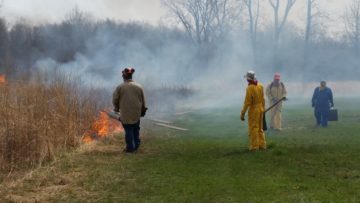By JAN LARSON McLAUGHLIN
BG Independent News
Earlier today, the bright orange flames devoured the tall prairie grasses and left behind several acres of charred ground. But in a matter of days, life will start bursting through the blackness.
“Within three or four days new life pops up,” said Cinda Stutzman, natural resources specialist with the Bowling Green Parks and Recreation Department.
As Stutzman watched the prairie burn in Wintergarden Park on Tuesday, she talked about the reason for the occasional controlled burns.
“We are trying to minimize the amount of woody plants and invasive species,” she said. And that will help flowers germinate and grow in the prairie area. Without the burns every one to three years, the blackberry and sassafras plants take over, she said.

Workers keep an eye on the fire.
The fire crew was led by Tim Mason, who has been doing controlled burns like this since 1970. To get rid of the woody plants, the crew was doing a backburn, followed by flash fires up the sides. “The fire has to work backward,” Stutzman said.
Once new life starts returning, there should be sunflowers and a variety of other wildflowers in the meadow.
“There will be lots of great wildflowers that are great for pollinators and butterflies,” she said.
The meadow was designed with pollinating plants in mind.
“The grasses are the backbone of the meadow,” and the flowers are the mosaic, Stutzman said. “The majority of the meadow has been reintroduced with a grass and flower mixture.”
The acreage of the entire Wintergarden Park is about 100 acres, with approximately 30 of that being field and meadow.
“I’ve been working pretty hard on this meadow for 15 years,” Stutzman said. “It’s been an honor and a privilege to work on this meadow.”
Now all the public has to do is visit Wintergarden and enjoy the rebirth of the meadow. “I hope the people of Bowling Green come out to see their flowers and butterflies this summer,” she said.

